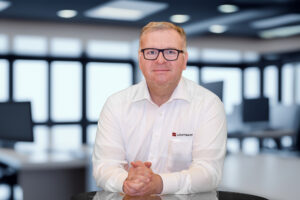The rapid growth of flexible workspaces, fueled by cutting-edge technology, is reshaping how organisations function. As businesses shift to more adaptive work models, tools like cloud computing, IoT-enabled smart offices, and AI-driven systems are becoming essential to enhance collaboration, productivity, and efficiency.
For our latest Round Table topic, “Flexible Workspaces Technology,” we spoke with experts and executives from Zoom, Nureva, Lightware, Vyopta and Logitech about the most compelling trends in flexible workspaces technology, the best practices for overcoming the challenges in choosing the best-fitting such technology, how flexible workspace technology can drive productivity and employee engagement in remote settings, and what the key trends in the space will look like in the next three-to-five years.
What are the most compelling trends in flexible workspace technologies in 2024?

Nancy Knowlton, CEO of Nureva
Knowlton highlights that the big trend in 2024 is the focus on tools and technologies being easy to use, which means they must be easily and naturally incorporated into a process or project.
“People don’t come to work to focus on using tools,” Knowlton said, “they come to use their brains, to be collaborative, to create something. To the extent that spending time learning about and then focusing on using technology distracts from the overall creative process.”
“To be clear, a certain amount of effort is needed to gain a degree of proficiency with a tool, but the speed with which we can get up the learning curve and have a level of mastery is what makes the difference.”
Jonathan Sass, VP of Product at Vyopta
For Sass, the most compelling current trends in flexible workspace technologies include a stronger emphasis on employee experience, improved interoperability, and the strategic use of collaboration data.
“Employee experience is now paramount, with technology and workspace design increasingly centred on employees’ needs rather than just technical specifications,” Sass expanded. “This shift underscores a broader acknowledgement of the value of user-centric solutions.”
Secondly, Sass observed that as organisations look to improve in-office user experience, they are pursuing solutions with enhanced interoperability driven by the end user’s need to connect to varied UC vendors and solutions. A preference is being placed on native interoperability.
“Lastly, the effective use of collaboration data has become vital to understanding user experience and collaboration trends,” Sass continued. “In particular, organisations are eager to analyse collaboration and utilisation trends to maximise return on investment, particularly as nearly 50 percent of conference rooms are often being used less than 10 percent of the time.”
Gergely Vida, CEO of Lightware
Vida noted that seamless integration, adaptability, and user-centric experiences count amongst the most compelling trends affecting the space today, particularly with the rise of voice-activated technologies.
“Lightware’s solutions make managing both personal and hybrid meetings more intuitive and effortless, ensuring seamless execution across diverse meeting spaces,” Vida explained. “Lightware’s award-winning technologies, when combined with leading voice tracking solutions like Yamaha or Sennheiser, deliver a truly unique and premium experience for users.”
“Our customisable, brand-agnostic ecosystem enables automatic, invisible room control in auditoriums of any size, making it a flexible solution for various environments.”
Nathan Coutinho, Director of Business Strategy at Logitech
Coutinho underlined that IT leaders have many marks to hit nowadays: They’re looking for flexible workspace tech that is suitable for a range of individual employee needs, can be managed remotely, optimises their office real estate, and is increasingly manufactured in an environmentally sustainable way.
“Meeting all those requirements can be daunting and has formed the most compelling 2024 trend in flexible workspace technology: sophisticated technology that brings all of these benefits into one offering,” Coutinho outlined. “They not only facilitate the desk booking experience but also offer IT departments precise insights into space and technology utilisation, helping bring employees back to the office while providing accurate insights to better use spaces and technology.”
Additionally, Coutinho said that Logitech has seen buyers of IT equipment become increasingly interested in purchasing tech with a lower environmental impact this year, making it critical to select tech that is designed for sustainability.
“Logi Dock Flex, for example, is made with recycled plastic, low-carbon aluminium and is packaged with FSC-certified recycled paper,” Coutinho explained.

John Stearns, Global Head of Zoom Spaces at Zoom
Stearns pinpointed several key trends in 2024, including AI-driven customisation, seamless hybrid collaboration, and advanced space management. All three provide employees with intuitive, flexible, and secure experiences.
“AI is changing the game when it comes to meeting room technology,” he said. “It can automatically adjust room layouts, pick the best camera angles, and personalise video streams, making sure everyone – whether in-person or virtual – feels heard, involved and included. Plus, it makes it easy to create flexible spaces that adapt to changing needs, from training rooms to huddle rooms to open workspaces.”
Stearns noted that Zoom is also seeing the integration of advanced reservation systems, which empower employees to effortlessly book everything from desks to lockers, simplifying their day and ensuring efficient use of the space when in the office.
“With the help of detailed analytics, businesses can optimise real estate usage like never before,” Stearns continued. “This shift is all about creating more efficient, inclusive, and adaptive work environments that meet the evolving demands of a flexible workforce.”
What are the major challenges organisations face in choosing the right technologies for them and then effectively deploying them, and what best practices and strategies would you advise them to overcome them?

Nathan Coutinho, Director of Business Strategy at Logitech
Coutinho stressed that choosing and deploying new technology always comes with a host of challenges. “For shared workspaces, the flexible nature of those setups inherently means that there is no ‘fixed’ solution that you can set and forget – instead, tech should be adaptable to evolving needs,” he explained. “Those needs include the ease of deployment and management for IT teams and the user experience of the employees.”
To overcome these challenges, Coutinho suggested IT should ensure that new tech is compatible with their existing ecosystem and can work cross-platform.
“To avoid disruption and encourage quick adoption by employees, the tech needs to be incredibly simple to use,” Coutinho said. “Teams should also stay on top of how their spaces are being used by tracking technology usage and performance accurately to enable real estate optimisation/office redesign, assess ROI, and plan future investments to continuously refine their technology selections.”
John Stearns, Global Head of Zoom Spaces at Zoom
Stearns outlined that Zoom often sees organisations struggle with the complexity of integrating new technologies into existing workflows.
“A key challenge is selecting technologies that not only meet immediate needs but also offer scalability and flexibility for future growth,” Stearns expounded. “Deployment can be hindered by a lack of employee buy-in, technical issues, and inadequate training.”
To overcome these challenges, Stearns argued that organisations should begin with a thorough needs assessment involving all stakeholders to understand specific requirements. He emphasised that prioritising solutions that offer interoperability can simplify adoption and support gradual deployment, backed by robust training programmes to ensure smoother transitions.
“This is particularly important when utilising AI-driven tools, as differences in uptake between employees and leaders still exist,” Stearns said. “It’s crucial to highlight the benefits of AI – from optimising workspaces to enhancing the employee experience – through training and open forums. Lastly, ongoing evaluation and feedback loops are essential for refining and improving the deployment process.”
Nancy Knowlton, CEO of Nureva
Knowlton noted that as a creator, she doesn’t want to spend my time staying on the cutting edge of the plethora of tools available today and tomorrow. Knowlton wants someone who knows what she needs to accomplish to give her the tools to help her be productive.
“That ‘someone’ doesn’t have to be a real person, although it could be,” she continued. “‘Someone’ could be the technology provider who adds features and functionality to their products and delivers them before I really know that I need them. I might discover them in an application and, with the smallest amount of instruction, begin to use them.”
“‘Someone’ might also be IT or HR, who chooses tools and lets me know why and how I would use them in my daily work. Sometimes, having guidance about when to use a tool is enough. Other times, a little more is required.”
Gergely Vida, CEO of Lightware
Vida outlined several challenges organisations face when selecting and deploying flexible workspace technologies, including the overwhelming number of options, ensuring compatibility with existing systems, and managing the costs associated with upgrades.
“One of the most significant hurdles is achieving seamless integration between new technologies, particularly in environments where Bring Your Own Meeting (BYOM) setups are prevalent,” Vida said. “Lightware’s Taurus UCX is specifically designed to address these common challenges. As a universal matrix switcher, it allows for convenient collaboration by enabling users to connect their own devices via a single USB-C cable.”
Vida added that this streamlined approach simplifies content sharing and room control, making it easier than ever to manage meeting rooms and collaboration environments effectively. “With the Taurus UCX, organisations can overcome integration hurdles and enhance the efficiency of their BYOM setups.”
Jonathan Sass, VP of Product at Vyopta
Sass purported that a key challenge organisations face is the disconnect between technologies implemented before and during the pandemic and employees’ current collaboration expectations. Notably, he added, more than one-third of conference rooms are now used by just one person for video conferencing or as a quiet workspace.
“A significant issue is the need for more data to understand this disconnect and make informed decisions about workplace technology and real estate investments,” Sass said. “To address this, organisations should gather metrics on collaboration trends, such as which technologies and spaces are being used and how often employees collaborate in-office versus remotely.”
“Additionally, focusing on the quality of the user experience and productivity is crucial,” he suggested. “Organisations must evaluate return on investment by balancing cost against business outcomes rather than simply opting for the lowest-cost option. Prioritising best-in-breed technologies across the stack ensures a more effective and satisfying deployment.”
In what ways can flexible workspace technology drive productivity and employee engagement in a remote or hybrid setting?

Gergely Vida, CEO of Lightware
Vida highlighted that flexible workspace technology, such as high-quality video conferencing systems and collaborative software, facilitates better interaction between remote and in-office participants.
“Features like real-time screen sharing, digital whiteboards, and chat functions ensure that everyone can contribute equally, regardless of their location,” he suggested. “Advanced systems also offer automated controls that manage room settings, such as lighting, audio, and video, based on the meeting type or participants.”
Vida outlined that his company’s Lightware Advanced Room Automation (LARA) integration offers significant corporate benefits by enhancing meeting efficiency and supporting sustainability.
“Embedded in the Taurus UCX, LARA can ensure that devices in the meeting space are ready to use by the start of the meeting and manage device behaviour all along, even after meetings,” he explained.
“It streamlines control by enabling management of the entire meeting room from a single touchscreen, which simplifies setup and helps participants concentrate on the meeting content. Additionally, LARA contributes to environmental sustainability by automating room switch-off to reduce energy consumption and eliminating the need for extra controllers, thereby cutting costs and supporting greener practices.”
Nathan Coutinho, Director of Business Strategy at Logitech
When given a choice in hybrid work, Coutinho stressed that the primary reason people come into the office is to see their colleagues in person.
“But it can be tricky to know who is coming into the office and when,” Coutinho caveated. “Making it as easy as possible to connect with one another and effortless to find a space to sit, potentially together, and/or find a room to meet is key to increasing employee engagement. This was the reason why we built both Logitech Room and Desk Booking — to create a seamless and frictionless experience for employees to adapt to work in the post-hybrid era.”
Coutinho suggested one mistake organisations make with hybrid and remote work is not equipping their employees for success in every possible environment they might choose to work in – home, office, or on the road.
“At home, we built Logi Dock to unify the array of cables and to give the user a central point to start meetings, mute audio or video, and provide calendar notifications with great quality mics and sound to provide the best possible audio, like they were in a meeting room.”
“At work, we built on the success of Logi Dock to create Logi Dock Flex, which removes the speakers and mics, adds a display, central manageability and native support for Logitech Desk Booking, Microsoft Teams, Zoom Desk Reservations and Logitech Desk Booking.”
Coutinho argued that when you combine these together, you bring a sophisticated, modern feel to work where employees can book their desks with their colleagues and choose a meeting room right from an app.
“At home, they can effortlessly log into meetings with one tap and have a democratised experience,” Coutinho added. “On the go, they can continue to have great audio with the Zone line of enterprise-grade headsets.”
“Finally, when they get to the office, they can use the same maps in the app to find their desk, meeting rooms and colleagues. No need to pull out cables from the bag — just plug in your laptop to the Logi Dock Flex, it auto logs you in, connects your displays and webcam, and work can begin. Taking all the friction away essentially removes the frustration and enhances productivity.”
Nancy Knowlton, CEO of Nureva
Knowlton underscored that people want to feel empowered to do their jobs, not burdened and overwhelmed.
“Feeling that they have the tools and the environment within which they can create will make all the difference,” she emphasised. “It also means having the people management processes aligned such that the trust is there, on both sides. What are the check-in points in the process? How can I get help when I need it, maybe even before I need it?”
John Stearns, Global Head of Zoom Spaces at Zoom
For Stearns, flexible workspace technology drives productivity and employee engagement by creating adaptive, inclusive environments that cater to both in-office and remote workers.
“AI-powered tools ensure that, regardless of location, all participants have an equitable experience, helping to maintain high levels of engagement and reducing the friction sometimes associated with hybrid meetings,” he said. “This results in more dynamic, engaging, and ultimately more productive interactions.”
Jonathan Sass, VP of Product at Vyopta
Similarly, Sass noted that flexible workspace technology plays a crucial role in boosting productivity and employee engagement in remote or hybrid settings. When the right technology is in place, Sass explained, participation rates naturally increase as technical issues are minimised, encouraging more active involvement.
“Meeting equity is also essential, ensuring everyone has an equal opportunity to participate, whether they are at home or in the office,” Sass added. “A key focus should be creating a positive experience for in-person and remote participants. For instance, AI-powered meeting technology can place all attendees in their own video frames, regardless of location, fostering a more inclusive and engaging environment.”
“By prioritising reliable, user-friendly technology that supports seamless interaction, organisations can enhance both productivity and engagement in hybrid work settings.”
What trends in flexible workspace technology should organisations be watching to stay ahead of the curve in the next 3-5 years?

Jonathan Sass, VP of Product at Vyopta
Sass believed that in the next three-to-five years, there will be a strong push to optimise new technologies to support flexible workstyles.
“One of the key trends that IT must address is the growing demand for a clear ROI,” Sass said. “Organisations will increasingly need to ensure that their technology spending is justified by tangible business outcomes.”
Sass affirmed that to achieve this, having robust data for decision support is crucial.
“This data must be linked to actual business results, enabling companies to justify their technology investments, enhance the employee experience, and make more informed business decisions,” Sass continued. “By focusing on ROI and data-driven insights, organisations can ensure that their technology investments are effective and aligned with broader business goals.”
Nancy Knowlton, CEO of Nureva
Knowlton prophesied that the big trend to watch and then work to harness is the practical application of AI and how it can help with creativity and productivity.
“This means experimentation and trials,” she said. “It also means open conversations about what’s working and what’s not.”
Gergely Vida, CEO of Lightware
Vida foretold that the continued evolution of AI and machine learning is set to revolutionise workspace environments by enhancing automation and optimisation.
“AI can transcribe and summarise meeting discussions, capturing key points and action items for distribution to participants, thus saving time and ensuring alignment,” he said. “Additionally, AI can use voice and gesture recognition to enable participants to control meeting features—such as adjusting the volume or changing presentation slides—without physical contact.”
Vida suggested another significant trend is the growing emphasis on sustainability and energy efficiency.
“As organisations become increasingly environmentally conscious, technologies that reduce energy consumption are gaining prominence,” Vida added. “Lightware is at the forefront of this trend, actively exploring ways to enhance the energy efficiency of our products, so our clients can achieve their sustainability goals while maintaining high performance.”
Nathan Coutinho, Director of Business Strategy at Logitech
For Coutinho, organisations should continue to investigate the impact of AI on software, hardware and platforms as they come together to bridge the gap between systems that were once isolated physically and managed by disparate teams.
“This means that flexible technology will continue to generate usage, insights and analytics that will undoubtedly raise the bar on employee experience,” Coutinho concluded.
from UC Today https://ift.tt/s6gAR7z



0 Comments